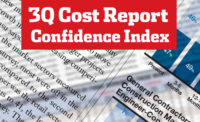2018 Q2 Cost Report
Despite Headwinds, Execs See Market Up Through 2019

The construction market has entered its tenth year of growth, and it seems the near-term outlook continues to be positive. What is surprising is that industry firms continue to see bright prospects throughout the next year, despite perceived headwinds caused by rising materials prices and staff shortages.
The near-term optimism, along with longer-term caution, can be seen in the results of the ENR Construction Industry Confidence Index survey. The CICI fell three points, to 70, in the second quarter. Of the 301 executives of large construction and design firms responding to the survey, most believe market growth will continue at least until mid-2019.
Beyond that, the execs are less optimistic. About 15% think the market will be in decline in 12 to 18 months, while 29% say it still will be in growth mode. But those percentages will reverse in three years, with 35% expecting a market decline and 16% still forecasting growth.
The CICI measures executive sentiment about the current market and where it will be in the next three to six months and over a 12- to 18-month period. A rating above 50 indicates a growing market.
The index is based on responses to surveys sent out between May 17 and June 18 to more than 6,000 U.S. firms on ENR’s candidate lists of leading general contractors, subcontractors and design firms.
CFMA: CFOs Surprisingly Sanguine
While most industry executives realize that the current bull market won’t last, most still see strength for another year or more. Many believe the domestic economy will continue to generate opportunities in construction for the immediate future, despite rising materials costs and staff shortages.
The soon-to-be-released results of the latest Confindex survey from the Construction Financial Management Association (CFMA), Princeton, N.J., show that while CFOs are worried about the long-term health of both the construction market and their businesses, the sector will continue to be good for now.
Each quarter, CFMA polls 200 CFOs from general and civil contractors and subs. The CFMA Confindex is based on four separate financial and market components, each rated on a scale of one to 200. A rating of 100 indicates a stable market; higher ratings show market growth is anticipated. “The overall Confindex rose from 116 in the previous quarter to 119 in the current quarter,” says Stuart Binstock, CFMA’s CEO.
All four components of the Confindex rose this quarter. The “general business conditions” component was up five points, to 124, and the “current conditions” component rose one point to 124. In addition, the “year-ahead outlook” went up by six points to 114, Binstock says, while the “financial conditions” component was up two points, to 116.
Binstock says the Confindex survey results are somewhat surprising because materials prices are on the rise and staff shortages continue to plague the industry, putting pressure on wages. “Both of these cost factors directly affect the bottom line, so it is a matter of concern to our members,” he says.
But Binstock says CFMA members seem to be unfazed. “The projected profit margins a year out in this quarter’s survey is similar to the last quarter.”
The thriving American economy has fueled this optimism. “We were in a 2% growth economy for a long time, but now it looks like we’re in a 3% growth mode, maybe higher,” says Anirban Basu, CEO of economic consultant Sage Policy Group Inc., Baltimore, and CFMA economic adviser. Owners now are more willing to make capital investments, he says.
This economic surge may explain why CFMA members are more heartened about the immediate future. “Firms are busier than ever and are maintaining their profit margins,” Basu says. While there continues to be concern about the costs of construction, “right now, owners seem to be willing to absorb the added costs from inflation.”
The scope of materials price pressure can be seen in this quarter’s CICI survey, which shows that 86.4% of respondents say they are experiencing price pressure on materials, up from 74.3% in the first quarter.
Steel prices are the biggest concern in the wake of the Trump administration’s tariffs (see related story, p. 16). Of the 301 CICI survey participants, 150 specifically mention steel prices as a major concern. Another 30 respondents mention price increases across the board, with many blaming the tariffs on steel and aluminum.
Staff shortages continue to worry the industry. The CICI survey asked whether these were getting worse over the past year. According to the survey, 47.5% say staff shortages are “somewhat worse” than last year, and an additional 14.3% say the shortages are “much worse.” Only 6.9% say the shortages have eased.
There is another cloud on the horizon. The U.S. Federal Reserve announced a rise in interest rates on June 13, and indications are the Fed may raise the prime rate again this year. This will increase the cost of project financing.
Only 14.6% of CICI respondents say that client access to capital for project financing has been tougher in the past six months. But many CFMA members say rising interest rates are a significant concern. “I think we will learn more about the impact of interest rates on industry confidence in the next quarter,” Basu says.


